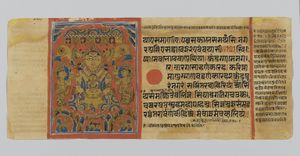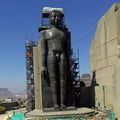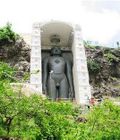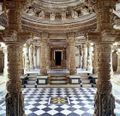ريشاباناتا
| ريشاباناتا | |
|---|---|
First Tirthankara | |
 Image of Rishabhanatha at Kundalpur pilgrimage site in Madhya Pradesh, India | |
| أسماء أخرى | Adinatha, Adish Jina (first conqueror), Adi Purush (first Perfect Man), Ikshvaku |
| التالي | Ajitanatha |
| الرمز | Bull[1] |
| القامة | 500 bows (1500 metres)[2] |
| العمر | 84 lakh purva (592.704 x 1018 years)[2] |
| الشجرة | Banyan |
| اللون | Golden |
| معلومات شخصية | |
| وُلِد | |
| توفي | |
| الأبوان | |
| الزوج | Sunanda and Sumangala |
| الأنجال | Bharata Bahubali Sundari Brahmi |
ريشاباناتا Rishabhanatha (وأيضاً Ṛṣabhadeva, Rishabhadeva, or Ṛṣabha[3]) is considered to be the first Tirthankara (Teaching God) of the present half cycle of time in Jain tradition.[4][5] The word Tīrthankara signifies the founder of a tirtha which means a fordable passage across a sea. The Tirthankara shows the 'fordable path' across the sea of interminable births and deaths (saṃsāra). Rishabhanatha is also known as Ādinātha which translates into "First (Adi) Lord (nātha)". According to Jain traditional accounts, he was born to King Nabhi and Queen Marudevi in Ayodhya. Jain texts talk about his two wives, Sunanda and Sumangala. Sumangala is described as the mother of his ninety-nine sons (including Bharata) and one daughter, Brahmi. Sunanda is depicted as the mother of Bahubali and Sundari. The sudden death of Nilanjana, one of the dancers of Indra, reminded him of the world's transitory nature and he developed a desire for renunciation. After being initiated as a Digambara monk, he is said to have wandered without food for a whole year. The day on which he got his first ahara (food), is celebrated as Akshaya Tritiya by Jains. He is said to have attained Moksha from Mount Kailash. Adi Purana contains the information over legends related to Rishabhanatha. His colossal statues include Statue of Ahimsa, Bawangaja and those erected in Gopachal hill. In iconography, Rishabhanatha is associated with his Bull emblem, the Nyagrodha tree, Gomukha (bull-faced) Yaksha, and Chakreshvari Yakshi.
تأسيس الجاينية
Jain cosmology divides the Worldly Time cycle into two halves (avasarpiṇī and utsarpiṇī) with six aras (spokes) in each half. Twenty-four Tirthankaras grace this part of the universe in the fourth period, known as duşamā-suşamā (read as dukhmā-sukhmā), of both halves. The present half cycle (avasarpiṇī) being a special case, Rishabhanatha, the first tīrthaṅkara was born at the end of the third period (known as suṣama-duṣamā) itself.[6][7] This cycle will start reversing at the onset of utsarpinī kāl (next half cycle) with the Dukhama-dukhamā being the first period.[8] According to Jain texts, Rishabhanatha was born in the age when there was happiness all around with no work for men to do.[6][9] Gradually as the cycle moved, and Kalpavriksha (wish-fulfilling trees) disappeared, people rushed to their King for help.[6][10] Rishabhanatha is then said to have taught the men six main professions. These were: (1) Asi (swordsmanship for protection), (2) Masi (writing skills), (3) Krishi (agriculture), (4) Vidya (knowledge), (5) Vanijya (trade and commerce) and (6) Shilp (crafts).[5][11][12] In other words, he is credited with introducing karma-bhumi (the age of action) by teaching these professions to householders to enable them to earn a livelihood.[13][14][15] The institution of marriage is said to have come into existence after he married to set an example for other humans to follow.[6][16][14] In total, Rishabhanatha is said to have taught seventy-two sciences which include: arithmetic, the plastic and visual arts, the art of lovemaking, singing and dancing.[16][17] Jain chronology places the date of Rishabhanatha at an almost immeasurable antiquity in the past.[18]
الأساطير
Rishabhanatha is known by many names among Jains including Adinatha, Adisvara, Yugadeva and Nabheya.[19] Ādi purāṇa, a major Jain text records the life accounts of Rishabhanatha as well as ten previous incarnations.[20]
الميلاد

Garbha kalyanaka is the first auspicious event out of five auspicious events (Panch Kalyanaka). It means enlivening of the embryo through the descent of the life (soul) in the mortal body. [21] On the second day of Ashadha (a month of the Hindu calendar) Krishna (dark fortnight), Queen Marudevi is said to have seen sixteen auspicious dreams. King Nabhi explained these dreams to her as a sign of Tirthankara's birth.[22]
Rishabhanatha was born to King Nabhi and Queen Marudevi in Ayodhya, on the ninth day of the dark half of the month of Chaitra-caitra krişna navamĩ.[6][23][24] This is the second auspicious event and is known as Janma Kalyanaka.[25]
التماثيل العملاقة
Statue of Ahimsa, Maharashtra, 108 feet (33 m)
Bawangaja, Madhya Pradesh, 84 feet (26 m)
Siddhachal Jain Temple, Gopachal Hill, Madhya Pradesh, 58.4 feet (17.8 m)
المعابد
Nasiyan Ji Jain temple, Ajmer
Adishwar Temple, Palitana
انظر أيضاً
المراجع
ملاحظات
الهامش
- ^ Shanti Lal Jain 1998, p. 46.
- ^ أ ب Sarasvati 1970, p. 444.
- ^ Sangave 2001, p. 131.
- ^ Zimmer 1953, p. 208-09.
- ^ أ ب Shanti Lal Jain 1998, p. 47.
- ^ أ ب ت ث ج Jaini 2000, p. 327.
- ^ Champat Rai Jain 1929, p. xiv.
- ^ Dalal 2010, p. 27.
- ^ Vijay K. Jain 2015, p. 78.
- ^ Champat Rai Jain 1929, p. 88.
- ^ Champat Rai Jain 1929, p. x.
- ^ Sangave 2001, p. 103.
- ^ Dundas 2002, p. 21.
- ^ أ ب Kailash Chand Jain 1991, p. 5.
- ^ Champat Rai Jain 1929, p. 89.
- ^ أ ب Rankin 2010, p. 43.
- ^ George 2008, p. 318.
- ^ Champat Rai Jain 1929, p. xv.
- ^ Umakant P. Shah 1987, p. 112.
- ^ Upinder Singh 2016, p. 26.
- ^ Zimmer 1953, p. 195.
- ^ Champat Rai Jain 1929, p. 76-79.
- ^ Vijay K. Jain 2015, p. 181.
- ^ Champat Rai Jain 1929, p. 83.
- ^ Jaini 1998, p. 7.
المصادر
- Students' Britannica India, 1–5, Popular Prakashan, 2000, ISBN 0-85229-760-2, https://books.google.com/books?id=AE_LIg9G5CgC
- Bhattacharyya, Pranab Kumar (1977), Historical geography of Madhya Pradesh from early records, Motilal Banarsidass, ISBN 0-8426-9091-3, https://books.google.co.in/books?id=njYpsvmr2dsC
- Cort, John E. (2010), Framing the Jina: Narratives of Icons and Idols in Jain History, Oxford University Press, ISBN 978-0-19-538502-1, https://books.google.com/books?id=MDBpq23-0QoC
- Dalal, Roshen (2010) [2006], The Religions of India: A Concise Guide to Nine Major Faiths, Penguin books, ISBN 978-0-14-341517-6, https://books.google.co.in/books?id=pNmfdAKFpkQC
- Doniger, Wendy, ed. (1999), Encyclopedia of World Religions, Merriam-Webster, ISBN 0-87779-044-2, https://books.google.co.in/books?id=ZP_f9icf2roC
- Dundas, Paul (2002), The Jains (Second ed.), Routledge, ISBN 0-415-26605-X, https://books.google.com/books?id=X8iAAgAAQBAJ
- George, Vensus A. (2008), Paths to the Divine: Ancient and Indian, XII, The Council for Research in Values and Philosophy, ISBN 978-1-56518-248-6, https://books.google.co.in/books?id=VYaRePV92YwC
- Gupta, Gyan Swarup (1999), India: From Indus Valley Civilisation to Mauryas, Concept Publishing Company, ISBN 978-81-7022-763-2, https://books.google.com/books?id=jbjT9GG__nEC
- Jain, Babu Kamtaprasad (2013), Digambaratva aur Digambar muni, Bharatiya Jnanpith, ISBN 81-263-5122-5, https://books.google.com/books?id=k--2oAEACAAJ
- Jain, Champat Rai (1929), Risabha Deva – The Founder of Jainism, Allahabad: The Indian Press Limited, https://archive.org/details/RisabhaDeva-TheFounderOfJainism, "
 هذا المقال يضم نصاً من هذا المصدر، الذي هو مشاع."
هذا المقال يضم نصاً من هذا المصدر، الذي هو مشاع." - Jain, Jyotindra; Fischer, Eberhard (1978), Jaina iconography, ISBN 90-04-05260-7
- Jain, Kailash Chand (1991), Lord Mahavira and his times, Motilal Banarsidass, ISBN 978-81-208-0805-8, https://books.google.com/books?id=8-TxcO9dfrcC
- Jain, Shanti Lal (1998), ABC of Jainism, Bhopal (M.P.): Jnanodaya Vidyapeeth, ISBN 81-7628-000-3
- Jain, Vijay K. (2015), Acarya Samantabhadra's Svayambhustotra: Adoration of The Twenty-four Tirthankara, Vikalp Printers, ISBN 978-81-903639-7-6, https://books.google.com/books?id=xI8HBgAAQBAJ, "
 هذا المقال يضم نصاً من هذا المصدر، الذي هو مشاع."
هذا المقال يضم نصاً من هذا المصدر، الذي هو مشاع." - Jaini, Padmanabh S. (1998) [1979], The Jaina Path of Purification, Delhi: Motilal Banarsidass, ISBN 81-208-1578-5, https://books.google.co.in/books?id=wE6v6ahxHi8C
- Jaini, Padmanabh S. (2000), Collected Papers on Jaina Studies, Motilal Banarsidass, ISBN 81-208-1691-9, https://books.google.com/books?id=HPggiM7y1aYC
- Krishna, Nanditha; Amirthalingam, M. (2014) [2013], Sacred Plants of India, Penguin Books, ISBN 978-93-5118-691-5, https://books.google.co.in/books?id=M_xsAwAAQBAJ
- Radhakrishnan, S. (1923), Indian Philosophy, The Macmillan Company, https://books.google.com/books?id=_k0uAAAAYAAJ
- Rankin, Aidan (2010), Many-Sided Wisdom: A New Politics of the Spirit, John Hunt Publishing, ISBN 978-1-84694-277-8, https://books.google.com/books?id=zoxR-LdZy0MC
- Rao, Raghunadha (1989), Indian Heritage and Culture, ISBN 978-81-207-0930-0, https://books.google.com/books?id=U-p8Zg62USYC
- Sangave, Dr. Vilas Adinath (2001), Facets of Jainology: Selected Research Papers on Jain Society, Religion, and Culture, Mumbai: Popular prakashan, ISBN 81-7154-839-3, https://books.google.com/books?id=2FGSGmP4jNcC
- Sarasvati, Swami Dayananda (1970), An English translation of the Satyarth Prakash, Swami Dayananda Sarasvati, https://archive.org/details/satyarthprakashl00dayauoft
- Shah, Natubhai (2004) [First published in 1998], Jainism: The World of Conquerors, I, Motilal Banarsidass, ISBN 81-208-1938-1, https://books.google.com/books?id=qLNQKGcDIhsC
- Shah, Umakant P. (1987), Jaina-rūpa-maṇḍana: Jaina iconography, Abhinav Publications, ISBN 81-7017-208-X, https://books.google.com/books?id=m_y_P4duSXsC
- Singh, Upinder (2016), A History of Ancient and Early Medieval India: From the Stone Age to the 12th Century, Pearson Education, ISBN 978-93-325-6996-6, https://books.google.com/books?id=Pq2iCwAAQBAJ
- Tandon, Om Prakash (2002) [1968], Jaina Shrines in India (1 ed.), New Delhi: Publications Division, Ministry of Information and Broadcasting, Government of India, ISBN 81-230-1013-3
- Titze, Kurt (1998), Jainism: A Pictorial Guide to the Religion of Non-Violence, Motilal Banarsidass, ISBN 978-81-208-1534-6, https://books.google.com/books?id=loQkEIf8z5wC
- Zimmer, Heinrich (1953), Joseph Campbell, ed., Philosophies Of India, لندن, E.C. 4: Routledge & Kegan Paul Ltd, ISBN 978-81-208-0739-6, https://archive.org/details/Philosophy.of.India.by.Heinrich.Zimmer, "
 هذا المقال يضم نصاً من هذا المصدر، الذي هو مشاع."
هذا المقال يضم نصاً من هذا المصدر، الذي هو مشاع."










